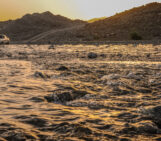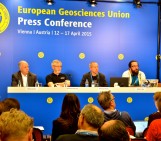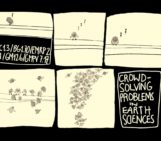
Hello Mavi! Welcome to GeoTalk. Before we start, could tell our readers a little about yourself and your background?
Hey Simon! Thanks for the warm welcome. I’m Maria Vittoria, but you can call me Mavi. I’m a curious soul from southern Italy, a physicist by passion, and a dreamer at heart. My journey has taken me from Italy to the UK and back, studying the tiniest particles to the vastness of the universe. I hold a PhD in Mathematics, Physics and Applications, and I’m also a qualified mediator.
My research today is focused on risk communication and stakeholder engagement, especially within Natural Hazards and Disaster Risk Reduction. I’ve been fortunate to work on some exciting EU-funded projects like CORE and The HuT, which aim to enhance our resilience against disasters.
Teaching is another passion of mine. I’ve spent nearly a decade helping students from high school to university grasp the complex concepts in the fields of Physics and of risk. I’m also a trained Positive Peace Activator, blending my love for science with a commitment to building a more peaceful world.
In short, I’m all about exploring, educating, and engaging to make a positive impact, especially in the field of Disaster Risk Reduction. Looking forward to our chat!
Understanding how hazards interact – or multi-risk assessment – marks a developing shift in how researchers approach hazards and risk. What makes this framework compelling?
Great question! Multi-risk assessment is a game-changer because it recognizes that hazards don’t happen in isolation. Instead of looking at risks individually, this approach considers how different hazards interact and compound each other, embracing the concept of systemic risk. It’s akin to solving a complex puzzle where every piece affects the others.
A crucial element in defining risk is the exposed value – the people, infrastructure, and resources at risk. The complexity of our society and communities adds another layer of intricacy, not just in how we assess risks, but also in how these risks are perceived and managed by those same communities. Different, coexisting hazards can interact in unpredictable ways, and the way a community understands and responds to these risks can vary widely.
This comprehensive view helps us create more effective and resilient strategies to mitigate risks. By understanding these interactions and the systemic nature of risk, we can better protect communities and infrastructure, making our world a safer place. It’s a holistic way of thinking that’s essential for tackling today’s complex challenges.
Discussing risk with both experts and stakeholders can be challenging; as a science communicator how do you approach talking about risk?
Communicating risk effectively is definitely a challenge, but also an incredibly rewarding one. When discussing risk, it’s crucial to distinguish between science communication and risk communication. Science communication focuses on sharing scientific knowledge broadly, while risk communication zeroes-in on conveying specific risks and their implications to various audiences.
As a science communicator, my approach involves all my experiences as educator, interpreter and mediator. For experts, I ensure our discussions are grounded in rigorous data and technical details. But when talking to stakeholders and the public, I translate complex concepts into relatable examples and clear visuals, making sure the core message is accessible and actionable.
Risk perception plays a huge role in how people understand and react to information; it’s deeply linked to cultural, heritage, psychological, and cognitive backgrounds.
For policy and decision-makers, this means presenting data in a way that aligns with their institutional frameworks and priorities. For individuals, it means connecting on a personal level, addressing their unique concerns and experiences. And never forget that policy and decision makers are individuals, first!
Imagine being a translator—it’s not just about converting words from one language to another, but about conveying the meaning and context behind those words. Similarly, in risk communication, it’s about translating scientific data into meaningful insights that resonate with people’s lived experiences.
Listening is key. By understanding the audience’s concerns and perspectives, I can tailor my message to build trust and encourage proactive engagement. Whether it’s through public forums, educational programs, or one-on-one conversations, my goal is to make sure everyone feels informed and empowered to take action on the risks that matter to them.
During your research, you also looked into how gaming can inform the public on hazards and risk. How do geoscience games help people to engage with such topics?
Geoscience games are powerful tools for engaging people with hazards and risks in a way that’s both educational and enjoyable. Through gamification and serious games, I’ve explored how interactive experiences can effectively communicate complex topics. Gamification involves applying game design elements like competition or rewards to non-game contexts, while serious games are specifically designed to educate or train, often using realistic simulations.
I’ve developed and participated in games and gamified lessons tailored for diverse audiences, from decision-makers to children as young as four years old. These games allow participants to interact with scenarios that mimic real-world challenges, such as earthquakes or floods, and make decisions based on risk assessments. This hands-on approach not only deepens understanding but also encourages critical thinking and proactive decision-making.
The beauty of geoscience games lies in their ability to make learning interactive and memorable.
By immersing players in virtual environments where they can experience the consequences of their actions, these games foster a deeper engagement with the material. Whether it’s navigating a city’s response to a tsunami or managing resources in a drought, players gain practical insights that can inform their understanding of hazards and preparedness strategies in the real world.
Moreover, creating and engaging with geoscience games is not just instructive—it’s also a lot of fun! It’s a fantastic way to learn while enjoying yourself, making it a win-win for capacity building, education and entertainment.
As the Early Career Scientist (ECS) representative for the Natural Hazards division at EGU; could you tell our readers how they can get more involved in the hazards community?
Absolutely! Getting involved in the Natural Hazards division is a great way to contribute and learn. Whether you’re passionate about natural hazards or just curious, there are many ways to dive in. You can start by reaching out to me – I’m here to connect you with Early Career Scientist activities like our blog, social media efforts, and events like Campfires (online peer-to-peer events) and webinars. Whether you’re keen to volunteer or simply want to listen and be part of the conversation, we welcome everyone!
As the ECS representative of the NH division, I’m also dedicated to promoting equality, diversity, and inclusion across all divisions. Together, we aim to build a collaborative, trans-disciplinary community where knowledge thrives and ideas flourish. Join us and make a difference in the NH and in the EGU community!






